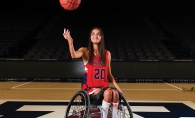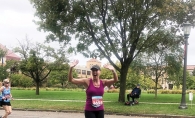
Local golfers are likely getting excited to hit the links as the weather warms. But if you’re about to shake the rust off of your swing after the long winter or have been recovering from any injury that’s prevented you from playing golf in a while, you may want to first consider a visit to the experts at Golftec located inside Twin Cities Orthopedics in Edina.
Golftec is a successful brand known for golf lessons and club fittings. Launched over 20 years ago by two young teaching pros, the company utilizes technology and data to give customized golf lessons and club fittings that help students lower their scores and play consistently better.
Improvements are made through the use of cameras and sensors attached to the body so that player and instructor can see exactly how the body moves through a swing along with the spin and trajectory of the ball. Years of recorded lessons provide Golftec’s instructors with tons of data from swings of very good and professional golfers as well as those who’ve swung a golf club for the very first time. Analysis of all of this data helps your golf pro focus on specific areas in need of improvement in your game.
But that’s not all. The specialists at Twin Cities Orthopedics understand the unique demands of the golf swing on the body and how to prevent injury for golfers. “Offering golfers smart training solutions and year-round access was a driver of this partnership [between Golftec and TCO],” says Jeff LaPanta, Edina therapy manager for TCO.
LaPanta notes that in Minnesota, golfers often spend the winter making golf resolutions to get better … and when spring comes, “they go from couch to tee box in zero to 60 without any thought to how their body is prepared to swing. This is a recipe for injury and regret.”
Golfers can avoid that scenario and stay active by training year-round in this state-of-the-art facility. That said, golfers tend to take more swings during indoor training sessions and do so in a shorter amount of time. So golfers should warm up and stretch to prevent injury and pain.
TCO therapists often see golfers with injuries and pain due to physical impairments that lead to faulty swing mechanics. “The Golftec technology allows our specialists to demonstrate to patients in real time the cause and effect of their physical impairments and their swing mechanics,” LaPanta says. The cameras don’t lie. Showing a patient what their posture looks like as they stand over a golf ball at address—and how to change this—allows them to see and not just feel what they’re doing. He says, “It’s often a psychological boost for patients to see why they have pain when they play golf and to realize how they can make changes with our help."
Or maybe you’re not simply trying to prevent injury but are recovering. “This technology allows golfers to safely return to the activity they love with the guidance of their therapist. We can allow safe practice for someone rehabilitating after surgery and can monitor their response not only in how they feel swinging the club, but also with exact measurement of body positions at key points in the swing as well as performance data such as swing speed and shot distances. It really takes the guesswork out of letting someone start back to play and allows us to start earlier in the rehab process,” LaPanta says.
So whether you’re hoping to improve your game or want to discover how best to swing those clubs without injury or pain, LaPanta says, “Our rehab team offers individualized, golf-specific training to help golfers improve their fitness, and the certified personal coaches provide swing lessons under the same roof. [It] works for all ages and abilities. We take care of elite athletes and those just hoping to move a little better."
According to LaPanta, golfers should pay attention to a few key areas:
- Perform 5-10 minutes of light cardio work, which can be a brisk walk, before stretching.
- Gentle, static stretching for large muscle groups of the lower body such as the hip flexors, hamstrings and glutes, as your legs are the foundation of your swing.
- Stretch the chest (pectorals) followed by small muscles of the shoulder (rotator cuff) as well as the forearms and wrists. Last but not least, stretch out the lower and middle back, especially into rotation, to prepare the body for the twisting involved in a golf swing.
- A few slow-motion practice swings should follow this routine. Your body and your golf instructor will appreciate your efforts.
GOLFTEC
4100 Minnesota Dr.
Facebook: Golftec
Twitter: @Golftec
Instagram: @Golftec









